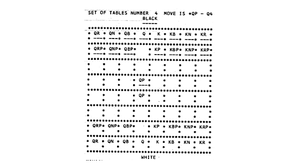Kotok-McCarthy
| Early Chess Programs at MIT | ||
| 1957–1958 | routines by John McCarthy and Paul W. Abrahams[1] | IBM 704 |
|---|---|---|
| 1959–1962 | Kotok-McCarthy | IBM 7090 |
| 1965–1967 | The Greenblatt program (Mac Hack) | DEC PDP-6 |

Kotok-McCarthy also known as A Chess Playing Program for the IBM 7090 Computer was the first computer program to play chess convincingly. It is also remembered because it played in and lost the first chess match between two computer programs.
Development
Between 1959 and 1962, classmates Elwyn Berlekamp, Alan Kotok, Michael Lieberman, Charles Niessen and Robert A. Wagner wrote the program while students of John McCarthy at the Massachusetts Institute of Technology.
Building on Alex Bernstein's landmark 1957 program[2] created at IBM and on IBM 704 routines by McCarthy and Paul W. Abrahams, they added alpha-beta pruning to minmax at McCarthy's suggestion to improve the plausible move generator. They wrote in Fortran and FAP on scavenged computer time. After MIT received a 7090 from IBM, a single move took five to twenty minutes. By 1962 when they graduated, the program had completed fragments of four games at a level "comparable to an amateur with about 100 games experience".[3] Kotok, at about age 20, published their work in MIT Artificial Intelligence Memo 41 and his bachelor's thesis.[3]
Match with ITEP
In 1965, McCarthy, by then at Stanford University, visited the Soviet Union. A group using the M-2 computer at Alexander Kronrod’s laboratory at the Moscow Institute for Theoretical and Experimental Physics (ITEP) challenged him to a match.[4] Kronrod considered Kotok-McCarthy to be the best program in the United States at the time.[5] Although some of its faults were known in 1965[6] and were corrected in the Greenblatt program at MIT Project MAC, Kotok-McCarthy was no longer in development and was three years out of date.
Georgy Adelson-Velsky, Vladimir Arlazarov, Bitman, Anatoly Uskov and Alexander Zhivotovsky won the correspondence match played by telegraph over nine months in 1966-1967. The Kotok-McCarthy program lost the match by a score of three to one[5] and the first two games were played with a weak version.[7] The ITEP group was advised by Russian chess master Alexander R. Bitman and three-time world champion Mikhail Botvinnik.[8] According to the Computer History Museum, McCarthy "used an improved version"[9] in 1967 but what improvements were made is unknown.
Influence
In 1967 Mac Hack VI[10] by Richard Greenblatt with Donald E. Eastlake III became an honorary member of the United States Chess Federation when a person lost to it in tournament play in Massachusetts. Kronrod lost his directorship at ITEP and his professorship because of complaints from physics users that ITEP mathematics resources were being used for gaming. Mikhail Donskoy, Arlazarov and Uskov developed the ITEP program into Kaissa at the Institute of Control Sciences and in 1974, it became the world computer chess champion.[11] Debate continues[12] some forty years after the first test, about whether the Shannon[13] Type A brute force approach, used by ITEP, is superior to the Type B selective strategy, used by Kotok-McCarthy.[7]
See also
Notes
- ↑ McCarthy, John (1996). "LISP prehistory - Summer 1956 through Summer 1958". Retrieved 2006-12-09.
- ↑ Mastering the Game: A History of Computer Chess, Computer History Museum (September 2005). "Opening Moves: Origins of Computer Chess". Retrieved 2006-12-17.
- 1 2 Kotok, Alan (3 December 2004). "MIT Artificial Intelligence Memo 41". Retrieved 2006-12-08.
- ↑ McCarthy, John (8 September 2005). The History of Computer Chess: An AI Perspective (Google Video). Mountain View, CA, USA: Computer History Museum. Retrieved 2006-12-08.. McCarthy begins at 0:43:48.
- 1 2 E.M. Landis, I.M. Yaglom, Remembering A.S. Kronrod, English translation by Viola Brudno. W. Gautschi (ed.) [written for Uspekhi Matematicheskikh Nauk, English publication Math. Intelligencer (2002), 22-30], available at Stanford University School of Engineering SCCM-00-01 (PostScript). Retrieved on 19 December 2006
- ↑ Greenblatt, Richard D. (12 January 2005). "Oral History of Richard Greenblatt" (PDF). Computer History Museum. Retrieved 2006-07-01.
- 1 2 Brudno, Michael (May 2000). "Competitions, Controversies, and Computer Chess" (PDF). Retrieved 2006-12-09.
- ↑ Gift of Monroe Newborn (photographer) (1980). "International Grandmaster and World Champion Mikhail Botvinnik in Moscow". Computer History Museum accession number 102645357. Retrieved 2006-12-24.
- ↑ Photo: John McCarthy, artificial intelligence pioneer, playing chess at Stanford's IBM 7090, Unknown photographer. Courtesy of Stanford University. (1967). "Computer History Museum accession number L062302006". Retrieved 2006-12-22.
- ↑ Greenblatt, Richard D., Eastlake, Donald E. III, and Crocker, Stephen D. (1969). "The Greenblatt Chess Program" (PDF). Massachusetts Institute of Technology. Retrieved 2006-07-01.
- ↑ Photo: Arlazarov, Uskov, and Donskoy in Moscow, Unknown photographer. Gift of M.M. Newborn. (1980). "Computer History Museum accession number 102645411". Retrieved 2006-12-18.
- ↑ Newborn, Monty (28 February 2005). "Oral History of Monty Newborn" (PDF). Computer History Museum. Retrieved 2006-12-17.
- ↑ Shannon, Claude E. (March 1950). "Programming a Computer for Playing Chess" (PDF). Philosophical Magazine, Ser.7, Vol. 41, No. 314. Retrieved 2006-07-01.
References
- Kotok, Alan (June 1962). "A chess playing program for the IBM 7090". Massachusetts Institute of Technology. Dept. of Electrical Engineering. hdl:1721.1/17406.
- MIT Computer Science and Artificial Intelligence Laboratory (CSAIL) (n.d.). "A Chess Playing Program (AIM-41)". Massachusetts Institute of Technology, CSAIL Digital Archive - Artificial Intelligence Laboratory Series.
- AIM-41 PostScript. Retrieved on 24 December 2006.
- AIM-41 PDF. Retrieved on 24 December 2006.
- MIT Computer Science and Artificial Intelligence Laboratory (CSAIL) (n.d.). "LCS/AI Lab Timeline".
- "Computer Chess History by Bill Wall". 2006. Archived from the original on 2006-04-10. Retrieved 2006-12-09.